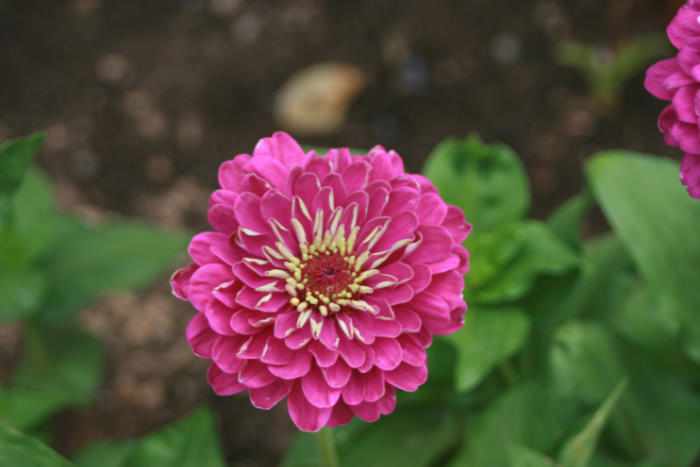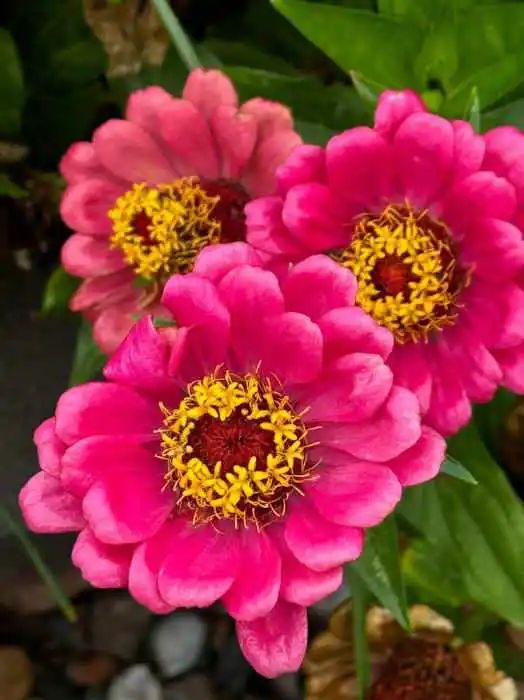Looking for annual flowers that bloom through even the hottest days of summer? Plant Zinnias. Even in Phoenix, zinnias continue blooming in the summer when many other annuals have stopped.
This post may contain affiliate links. Please see my disclosure policies. If you purchase after clicking an affiliate link we may receive small commission at no cost to you. As an Amazon Associate I earn from qualifying purchases.
Why We Love Zinnias!
Zinnias belong to the Asteraceae family, also known as the daisy family or the sunflower family. They can grow pretty tall.
Some varieties will reach up to 3 feet. Keep this in mind when deciding where to plant them in your yard.
They are a great annual flowers for summer as they love the sun. If you’re gardening in Phoenix there are not too many annual flowers blooming in June or July, so this is a great addition to add to your summer flower garden.
They are available in some stunning bold colors and the butterflies love this flower.
Where can Zinnias Grow?
Zinnias are very versatile and can grow in gardening zones 3-10.
They love full sun, so find a spot in your garden that gets at least 6 to 8 hours of sunlight each day. If you’re in a hot climate, like Phoenix Arizona plant them where they will have morning sun and afternoon shade.
They’re not too fussy about soil but prefer well-drained, fertile ground. If your soil is heavy clay, consider amending it with compost to improve drainage.
If you’re short on garden space, zinnias do just as well in containers. Choose a pot with good drainage and use high-quality potting soil.
Containers also have the advantage of being movable, so you can chase the sun as needed. Just remember you will need to water more frequently if you grow in a container.
Zinnias make excellent border plants, adding vibrant color along pathways or garden edges. They’re also great for filling in gaps in your garden, creating a lush, colorful display.
When to Plant Zinnias
Plant zinnias after the last frost date in your area. In Phoenix, gardening zone 9b you can plant in March. They’ll bloom throughout the summer and into early fall.
To enjoy continuous blooms throughout the season, consider succession planting. Sow seeds every two to three weeks, up until mid-summer.
This staggered approach ensures you always have fresh flowers and a colorful summer garden.
How to Plant Zinnias
Plant from seed after the danger of frost has passed. In Phoenix, the best month to plant is March. We personally grow them in a raised garden bed by seed every season.
I like the tall varieties so we use plant them in the back of the bed to provide shade for the shorter annual flowers in the front.
From Seed
- Loosen the soil to a depth of about 6-8 inches. Mix in some compost or well-rotted manure to enrich the soil.
- Plant seeds about 1/4 inch deep and space them 6-12 inches apart, depending on the variety.
- Water the soil gently but thoroughly after planting.
Transplants
- If starting indoors or buying seedlings, transplant them into the garden after the last frost date. Space them according to the variety’s needs.
- Water immediately after transplanting to help settle the soil around the roots.
How to Care for Zinnias
Zinnias love the sun and will provide beautiful blooms all summer, but they need regular watering. Provide supplemental water if it is particularly dry or hot.
Water at the base of the plant to avoid wetting the foliage, which can lead to mildew.
Avoid high-nitrogen fertilizers, as they can produce more foliage than flowers.
Deadheading, or removing spent blooms will encourage continuous flowering or if you would prefer you can let it go to seed.
Types of Zinnias
One of the best things about Zinnias are all the choices in colors and types of Zinnias available. Here are some popular types:
Zinnia Elegans
These are the most common zinnias, known for their large, dahlia-like blooms. They come in a rainbow of colors and can grow up to 3 feet tall.

Zinnia Angustifolia
Also known as narrow-leaf zinnias, these have smaller, daisy-like flowers and are more compact, making them perfect for borders and containers. They’re also more resistant to mildew.
Zinnia Haageana
Mexican zinnias, as they’re commonly called, have a bushy growth habit and vibrant, bi-colored blooms. They’re great for adding a splash of bold color to your garden.
Zinnia Profusion
A hybrid between Zinnia elegans and Zinnia angustifolia, Profusion zinnias are disease-resistant and produce a profusion of smaller blooms. They’re ideal for mass plantings and containers.
The Benefits of Growing Zinnia
- They have a long blooming season. Zinnias bloom from early summer until the first frost, providing non-stop color.
- Easy to grow, they are low-maintenance and forgiving, even if you’re still learning the ropes.
- Zinnias attract bees, butterflies, and hummingbirds, which are essential for a healthy garden ecosystem.
- They make excellent cut flowers, lasting a long time in bouquets. Snip a few for your indoor arrangements to bring a part of your garden indoors.
- With so many types and colors, zinnias can fit any garden style, from formal flower beds to casual wildflower mixes.

So named for their unique “spiky” appearance, Cactus Flowered Zinnias have petals that … [More]

Incredibly heat and drought tolerant, Mexican Zinnias, like our Persian Carpet Mix, thr… [More]

Grow Heirloom Zinnias – Plant California Giants Zinnia SeedsDeveloped in 1926, Heirloom… [More]
Good Companion Plants for Zinnias
- Basil
- Cosmos
- Marigolds
- Sunflowers
Basil is a great companion plant for a lot of flowers. It not only tastes great and attracts the bees, basil also helps deter pests. Plus, it’s convenient to have fresh herbs right next to your flowers.
If you’re going for the wildflower garden look, cosmos and zinnias create this with their similar growth habits and vibrant colors. They both attract beneficial insects, enhancing pollination.
Marigolds repel pests, making them a perfect pairing. Marigolds’ shorter height also complements the taller zinnia varieties.
Tall sunflowers provide a dramatic backdrop for zinnias and can offer some shade in hotter climates, protecting zinnias from the harshest afternoon sun.
Whether you’re a beginner or a seasoned gardener, zinnias are a beautiful summer annual flower. They’re easy to plant, care for, and offer a burst of color that lasts all season long. Happy summer gardening!


